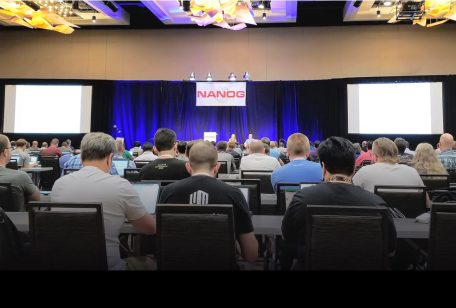
MDC Newsroom
Hundreds of network engineering, operations, and architecture professionals gathered earlier this week at the Texas capital to network and discuss the current state of the internet at NANOG 77.
It’s no surprise that peering and internet exchange are hot topics at any of NANOG’s tri-annual events.
Industry experts lead in-depth discussions, like Kyle Spencer, Executive Director of the Uganda Internet Exchange Point, delivered a presentation that explained the trends and the impacts of internet exchange points in edge markets. NANOG also features events like the Peering Coordination Forum that enable organizations like Microsoft, Google, Twitch, and MDC with public peering exchange points to present and advocate their solutions.
But despite the prevalence of the subject at the conference, peering and internet exchange experts made up a very small minority at NANOG 77. A guerilla survey conducted by Martin Hannigan, founder of DeepEdge, showed that out of the more than 700 respondents only 3.7% attended on behalf of an IXP and out of the 19 organizations that participated in the Peering Coordination Forum at NANOG77, only one focused solely on peering with Mexican carriers.
Mexico needs peering
When it comes to the number of internet users, Mexico is now the second-largest country in Latin America and commands the largest gaming market in the region. But Mexico is just getting started, according to Cisco:
- In Mexico, Internet traffic will grow 2.6-fold from 2016 to 2021, a compound annual growth rate of 21%.
- Busy hour Internet traffic will grow 4.2-fold from 2016 to 2021, a compound annual growth rate of 33%.
- Internet traffic will reach 2.7 Exabytes per month in 2021, up from 1.0 Exabytes per month in 2016.
- Internet traffic will be 89 Petabytes per day in 2021, up from 30 Petabytes per day in 2016.
If we take a closer look at how Mexican networks distribute their traffic, you will notice that the country is essentially split into two: the northern half of Mexico and the southern half of Mexico.
The southern half of Mexico is served from areas like Mexico City, Querétaro, and the surrounding markets. This means all that traffic in the northern half of Mexico is routed through the United States. To better illustrate the problem, Oracle gathered data on a week’s worth of traceroutes and showed how packets that originating in Guadalajara destined for Mexico City had to travel across the border to the United States – forcing all traffic to cover more ground and be billed transit rates.
Peering with Mexican Networks
Now, due to the lack of access to local and international content, the lack of neutrality, and the lack of participation by the country’s largest operators, IXPs in Mexico have not been successful. So how can operators peer with Mexican networks?
The most viable solution is to find a carrier-neutral data center that hosts the majority of Mexican networks and provides a functional Internet Exchange Point along the border.
McAllen, TX (halfway between Dallas and Mexico City and just 10 miles from the U.S. border with Mexico) continues to be one of the key crossing points where Mexican carriers gather to interconnect to Tier-1 networks and Content Providers.
McAllen is also home to MDC Data Centers and the MEX-IX, the only IXP in the United States focused on peering with Mexico.
There’s no doubt that the smart way to start peering with Mexican carriers is to begin exchanging traffic in McAllen, where it is not just more efficient but also more cost-effective. With MDC, you can benefit from carrier-neutrality, carrier-density, an exchange platform, and the ability to deliver your services to Mexico without the regulatory hassle all while operating from the United States.
Let’s continue talking about peering with Mexican networks. Connect with Joel Pacheco, MDC’s peering evangelist and Head of Marketing and Product, or fill out the form below to download our brochure and learn more about the MEX-IX.








